#xiaotingia
Text

Specimen #33616
Xiaotingia Zhangi
I had this thought, what if dinosaurs were still around? Would we keep the smaller ones like this guy as bird specimens? (timelapse below)
243 notes
·
View notes
Text
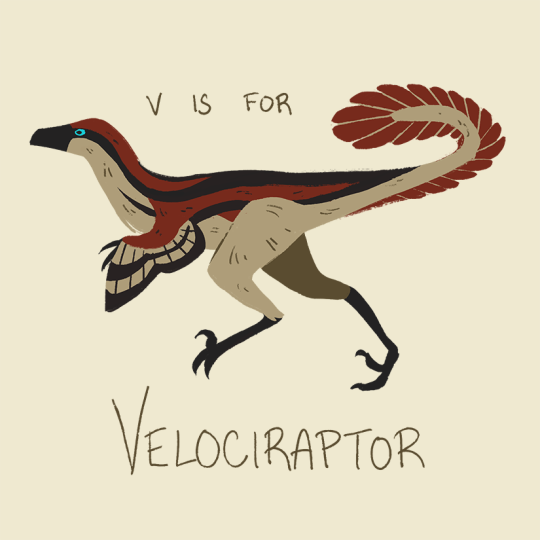


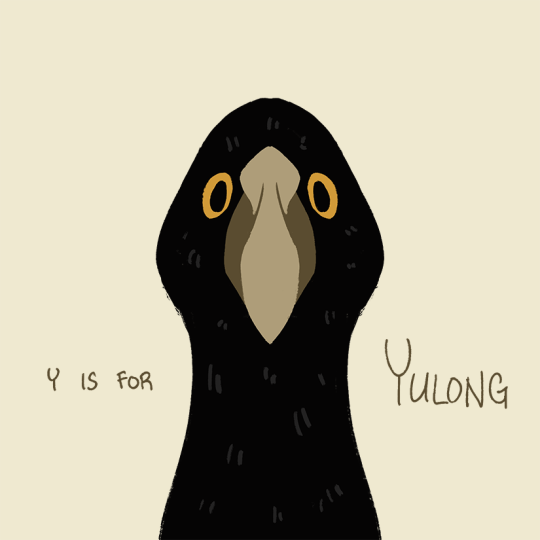

The Maniraptoran Alphabet (Part 5)
Aaaand here's the fifth and final part of my dinosaur alphabet! Thanks for joining me, everyone - I hope you enjoyed it! Let me know if you'd be interested in a physical book or poster or something of these together; I'm planning on making something like that for myself & friends and I would be happy to make a few extra to sell if there's interest.
#dinosaur#alphabet#maniraptoran#dromaeosaurid#troodontid#oviraptorid#velociraptor#wulong#xiaotingia#yulong#zhenyuanlong#paleoart#illustration#artaneae#I chose blue and yellow for xiaotingia because I hadn't used those colors as much on the rest of them (it was one of the last ones I drew)#but a friend of mine pointed out that the coloration just makes it look like metal sonic#so that's cool.
111 notes
·
View notes
Note
Trick or treat!! 🦢

Xiaotingia!
17 notes
·
View notes
Text


#Archovember Day 1 - Your Choice!
In my ongoing effort to draw all the non-avian dinosaurs we know the colors of, I’ve chosen Anchiornis huxleyi!
The type species for the Anchiornithids (“near birds”), Anchiornis huxleyi was a crow-sized dinosaur living in the Late Jurassic of Liaoning, China. It was relatively common, as hundreds of specimens have been uncovered in this area. But what makes Anchiornis so unique and important is that it was the first Mesozoic dinosaur species to have its entire life appearance be known by man! Having hundreds of well-preserved fossils available allows us to extract a lot of information about not only its size and shape, but its skin, feathers, and even coloration. Anchiornis had long wing feathers on its arms and legs (though its leg feathers were not as long as those of Microraptorians), fluffy downy feathers all over its body, a feathered crest on its head, and feathers covering its feet.
Only two Anchiornis fossils have had their well-preserved melanosomes studied so far. By comparing the structure of these melanosomes to modern birds, paleontologists have been able to infer the life colors of Anchiornis! It had mostly gray and black body feathers and white forewing and hindwing feathers with black tips. Its tail colors remain unknown. The first specimen of Anchiornis to be surveyed for melanosomes also had red or rufous coloring on its crest, as well as rufous speckles on its otherwise black and gray head. However, the second specimen did not have any rufous coloration. This may be due to different preservation of melanosomes, different investigative techniques, the animals in question having regional differences or even being different species/subspecies, the second Anchiornis being younger, or sexual dimorphism.
While Anchiornis had rather large feathered forelimbs, it didn’t seem to have been much of a flier. Unlike the later Microraptorians, its wings were rounded and relatively short compared to other flying dinosaurs, and the flimsy flight feathers overlapped each other to strengthen them. A 2016 study concluded that while juvenile Anchiornis may have been able to use their wings to assist with leaping through the trees, adults were simply too heavy and their wings too small to gain any lift. Instead, it is more likely their wings were used for display. As their legs were long, they may have been adapted for speed, using their wings to aid in aerodynamics as they quickly darted through the underbrush.
Pellets (such as those coughed up by owls) have been found both within and in association with Anchiornis, and contained lizard bones and fish scales. Prey items that could have also been eaten by Anchiornis include insects, arachnids, salamanders, small anurognathids (such as Cascocauda, who we will be visiting later this month) and other small or juvenile pterosaurs, and small cynodonts like Agilodocodon and Juramaia.
Anchiornis lived alongside other Anchiornithids such as Aurornis, Caihong, Eosinopteryx, Pedopenna, Serikornis, Xiaotingia, as well as the Scansoriopterygids Yi, Scansoriopteryx, and Epidexipteryx. It also lived alongside the quilled heterodontosaurid Tianyulong.
#my art#SaritaDrawsPalaeo#Anchiornis huxleyi#Anchiornis#Anchiornithid#paravian#theropods#saurischians#dinosaurs#archosaurs#archosauromorphs#Archovember#Archovember2023
25 notes
·
View notes
Text




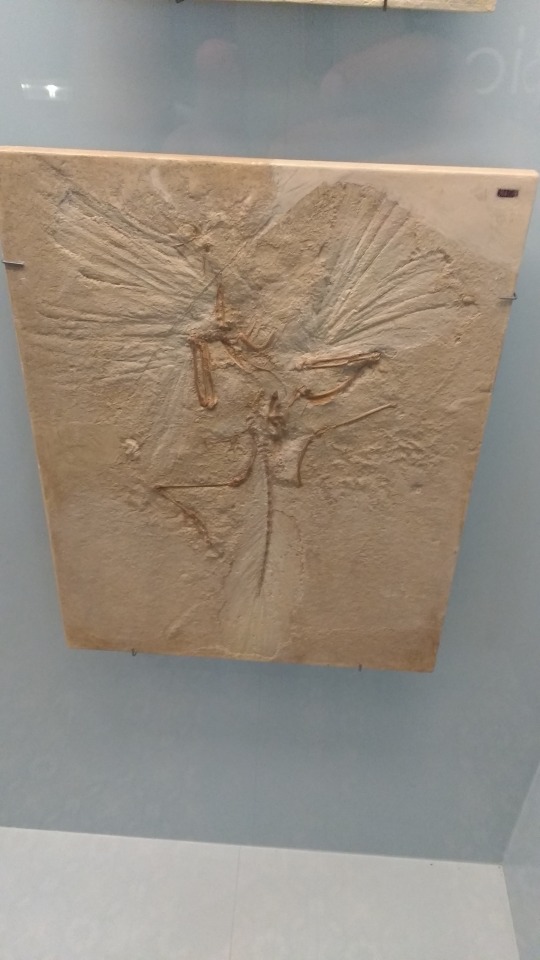

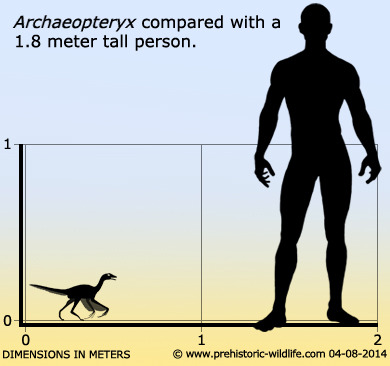
Archaeopteryx
(temporal range: 150.8-148.5 mio. years ago)
[text from the Wikipedia article, see also link above]
Archaeopteryx (/ˌɑːrkiːˈɒptərɪks/; lit. 'old-wing'), sometimes referred to by its German name, "Urvogel" (lit. Primeval Bird), is a genus of avian dinosaurs. The name derives from the ancient Greek ἀρχαῖος (archaīos), meaning "ancient", and πτέρυξ (ptéryx), meaning "feather" or "wing". Between the late 19th century and the early 21st century, Archaeopteryx was generally accepted by palaeontologists and popular reference books as the oldest known bird (member of the group Avialae).[2] Older potential avialans have since been identified, including Anchiornis, Xiaotingia, and Aurornis.[3]
Archaeopteryx lived in the Late Jurassic around 150 million years ago, in what is now southern Germany, during a time when Europe was an archipelago of islands in a shallow warm tropical sea, much closer to the equator than it is now. Similar in size to a Eurasian magpie, with the largest individuals possibly attaining the size of a raven,[4] the largest species of Archaeopteryx could grow to about 0.5 m (1 ft 8 in) in length. Despite their small size, broad wings, and inferred ability to fly or glide, Archaeopteryx had more in common with other small Mesozoic dinosaurs than with modern birds. In particular, they shared the following features with the dromaeosaurids and troodontids: jaws with sharp teeth, three fingers with claws, a long bony tail, hyperextensible second toes ("killing claw"), feathers (which also suggest warm-bloodedness), and various features of the skeleton.[5][6]
These features make Archaeopteryx a clear candidate for a transitional fossil between non-avian dinosaurs and birds.[7][8] Thus, Archaeopteryx plays an important role, not only in the study of the origin of birds, but in the study of dinosaurs. It was named from a single feather in 1861,[9] the identity of which has been controversial.[10][11] That same year, the first complete specimen of Archaeopteryx was announced. Over the years, ten more fossils of Archaeopteryx have surfaced. Despite variation among these fossils, most experts regard all the remains that have been discovered as belonging to a single species, although this is still debated.
Archaeopteryx was long considered to be the beginning of the evolutionary tree of birds. However, in recent years, the discovery of several small, feathered dinosaurs has created a mystery for palaeontologists, raising questions about which animals are the ancestors of modern birds and which are their relatives.[12] Most of these eleven fossils include impressions of feathers. Because these feathers are of an advanced form (flight feathers), these fossils are evidence that the evolution of feathers began before the Late Jurassic.[13] The type specimen of Archaeopteryx was discovered just two years after Charles Darwin published On the Origin of Species. Archaeopteryx seemed to confirm Darwin's theories and has since become a key piece of evidence for the origin of birds, the transitional fossils debate, and confirmation of evolution.
12 notes
·
View notes
Photo
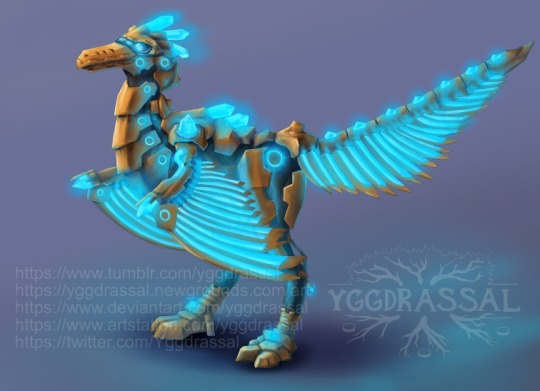
Didn't know what to do for an actual scene here, but I liked the sketch, so here it is. My randomizer gave me magitech and a xiaotingia. Don't know what type of animal that is? Neither do I! Apparently its some sort of bird dinosaur.
4 notes
·
View notes
Text
so i’m looking into proto-avian species for reasons you need not know and. i’m absolutely in love with the drawing of xiaotingia zhengi on the wikipedia page that’s CLEARLY made with colored pencils on printer paper. i mean not only is this like Direct evidence that someone loved x. zhengi enough to take the time out of their day and draw it for wikipedia but also like. they made x. zhengi damn cute
3 notes
·
View notes
Note
Raptor cookie was Inspired by two Dino’s-
Raptors mainly and the Xiaotingia zhengi
Which look like this
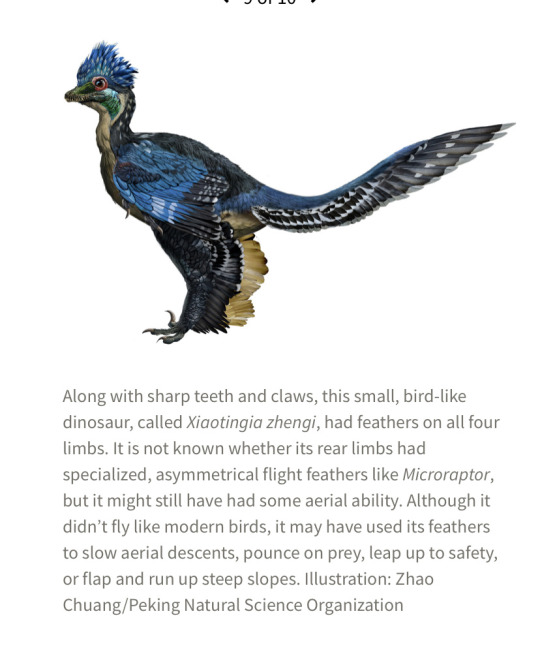
F E A TH E R
N i c e
0 notes
Text
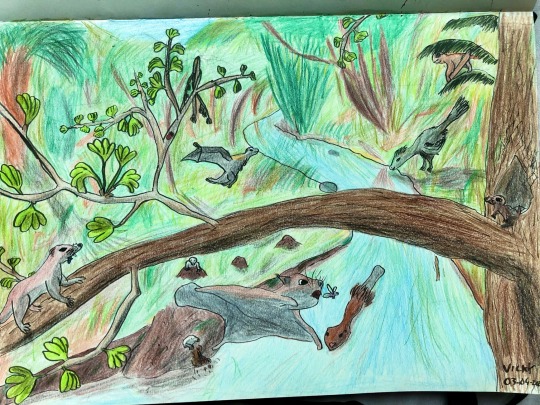
Here’s some of the amazing diversity of Mammaliaformes of Jurassic China. Volaticotherium glides in pursuit of a tasty bug. Agilodocodon, an excellent climber, already got one and brings it back to its young in the trees. Some Docofossors are digging up the lawn. Castorocauda, the largest mammaliaform of the Mesozoic, is going for a swim. With the exception of Volaticotherium, these are all Docodonts, a group closely related to the crown group mammals, having branched off a little before the monotremes did. I wanted to show off how much more diverse and interesting Mesozoic mammals were than we usually imagine. They did a lot more than cowering from dinosaurs and being eaten by them!
That said, Jurassic China also had some really cool dinosaurs.Yi qi, the actual real-life dragon, is going for a flight. A truly enormous Xiaotingia is having a drink. Please mentally halve the size of that big boy, I accidentally drew it way too large, that is a little birdie that should be easily outsized by Castorocauda. Finally, being neither a dinosaur nor a mammal, the not at all confusingly named pterosaur Cascocauda is sitting in the trees getting ready for a flight.
#mammaliaform#volaticotherium#castorocauda#docodonta#agilodocodon#docofossor#eutriconodonta#yi#yi qi#scanseriopterygid#xiaotingia#avialan#anchiornithid#cascocauda#pterosaur#anurognathid#mesozoic mammals#jurassic#paleoart#palaeoart#my art#i'm seriously kind of annoyed with how big i made xiaotingia#it feels like it's stealing the thunder of the mammals#especially castorocauda#i'm too used to drawing dromaeosaurs#anchiornithids are teeny tiny compared to them#dinosaur#mammal
39 notes
·
View notes
Photo

i'm honestly so obsessed with dinosaurs i thought about seeing what it would look like to turn all my sonas into dinosaurs themselves
of course, most of my aliases are ridiculous hybrids so, it wouldn't be any less of such in dino form xD here i mixed a Terror Bird with a Xiaotingia for Wylie's transformation!
originally being a parrot / vulture mix- i couldn't find any prehistoric birds similar to vultures that intrigued me, but then i remembered Terror Birds and how much i love them?
looking for prehistoric feathered friends was quite a feat, as you're either given bat-winged dinos such as the Quetzalcoatl and the Pteranodon, or several theropod and raptor friends. as much as i ADORE raptors, i wanted to do something a little different for once.
now, the Xiaoti resembles Microraptors in looks, but are depicted to be much more colourful so i went with that! it was either that or an Archaeopteryx Cx
i'm not very creative but this was fun to make nonetheless! definitely thinking about how to transform my other bois >83c
i'm sure Wylie would look amazing anthrofied in this form eeee gonna have to try it sometime
#Wylie Chaluri#my sona#Terror Bird#Xiaotingia Xhengi#Xiaotingia#dinosaur#dino#prehistoric birds#hybrid#avian#bird#burd#feathers#feral#scalie#furry#furry art#iDoodle2Draw#iD2D#art#artwork#drawing#digital drawing#sketch#colored sketch
30 notes
·
View notes
Photo
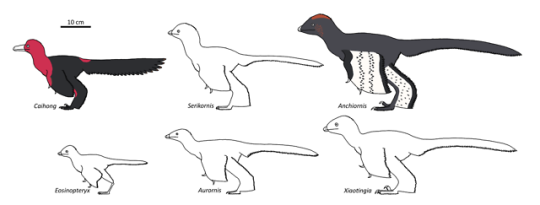
What did the last common ancestor of Velociraptor and modern birds look like? Anchiornithids might give us a clue. These small dinosaurs lived 160 million years ago and are known from incredible fossils, often complete with skin and feathers.
Full view
#Palaeoblr#Birblr#Dinosaurs#Birds#Anchiornis#Xiaotingia#Caihong#Serikornis#Aurornis#Eosinopteryx#Anchiornithids
41 notes
·
View notes
Text
Dinovember day 24. Xiaotingia.

0 notes
Text

Photo taken by me at a museum
the second one is a chicken, as said in the caption
265 notes
·
View notes
Text
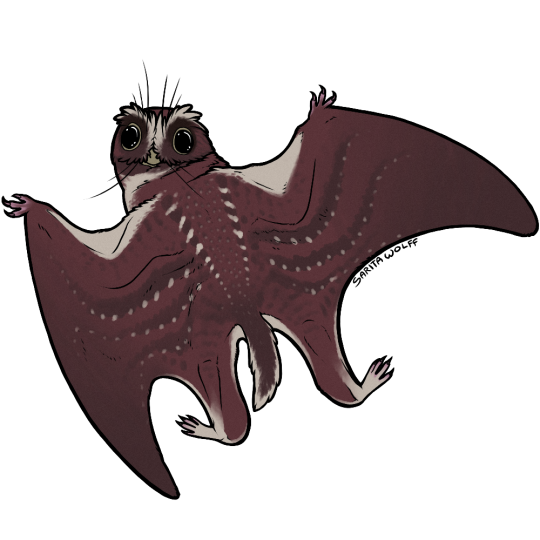
#Archovember Day 18 - Cascocauda rong
The Anurognathids of the Jurassic and Cretaceous were highly derived pterosaurs that filled a similar niche to bats. They were nocturnal or crepuscular, insectivorous (though some larger species may have eaten fish as well), arboreal, and had short tails. However, Cascocauda rong of Middle - Late Jurassic China was an exception to the short tail rule. It’s tail was longer than other known anurognathids, earning it a name meaning “fluffy ancient tail.” But more importantly, Cascocauda provides us evidence of the complexity of pycnofibers in pterosaurs. Long thought to be simple and furlike, pterosaur pycnofibers were thought to be unique structures that evolved independently from feathers. However, Cascocauda had an array of different pycnofiber shapes and structures, one of them being similar to downy feathers with frayed ends. This further strengthens the hypothesis that feathers evolved before dinosaurs and pterosaurs even split into two different clades. Also, infrared spectral analysis was used on these pycnofibers, showing they had a similar absorption spectra to red human hair, making Cascocauda one of the only pterosaurs for which we know its coloration!
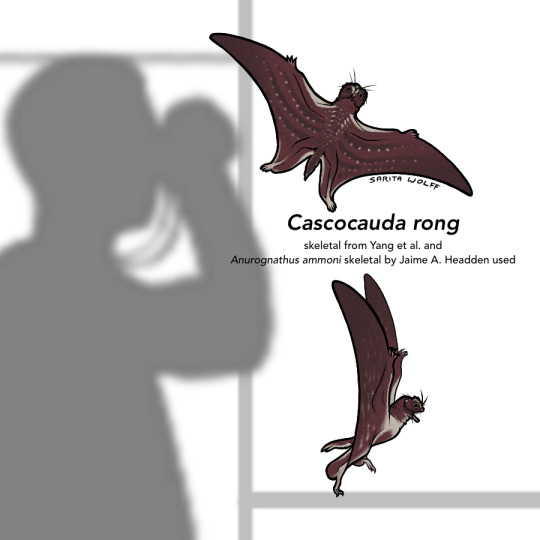
Found in the Tiaojishan Formation, Cascocauda rong would have lived with other anurognathids like Jeholopterus, Sinomacrops, and the tiny Luopterus. A wealth of other types of pterosaurs existed here as well, such as Darwinopterus, Kunpengopterus, Archaeoistiodactylus, Pterorhynchus, Wukongopterus, Daohugoupterus, Douzhanopterus, Fenghuangopterus, Jianchangnathus, Jianchangopterus, Qinglongopterus, and Liaodactylus. Dinosaurs lived here too, including the famously colored Anchiornis and other Anchiornithids like Aurornis, Caihong, Eosinopteryx, Pedopenna, Serikornis, and Xiaotingia, as well as the bizarrely bat-winged Scansoriopterygids Epidexipteryx, Scansoriopteryx, and Yi, and the quilled heterodontosaur Tianyulong. Arboreal cynodonts like Agilodocodon, Juramaia, Maiopatagium, Arboroharamiya, Volaticotherium, Vilevolodon, and Xianshou would have shared the trees with Cascocauda rong, adding to the busy, fluffy, feathery nature of this ancient forest.
#my art#SaritaDrawsPalaeo#Cascocauda rong#Cascocauda#anurognathids#pterosaurs#archosaurs#archosauromorphs#reptiles#Archovember#Archovember2023
24 notes
·
View notes
Photo

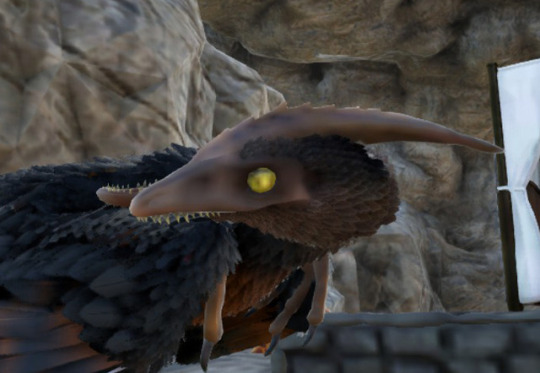
meanwhile, in ARK.
53 notes
·
View notes
Text

A Xiaotingia hiding in the undergrowth
#paleoart#it's not real it's a model made of pheasant and grouse feathers do not act like I'm trying to trick you#sculpture#feathered dinosaur
306 notes
·
View notes